The Basilica of San Domenico is a Gothic-style church in Arezzo, Tuscany, Italy, dedicated to St Dominic. It is especially renowned for housing a painted crucifix (1265) by Cimabue.

The Basilica of San Domenico is a Gothic-style church in Arezzo, Tuscany, Italy, dedicated to St Dominic. It is especially renowned for housing a painted crucifix (1265) by Cimabue.

The construction began in 1275 and was completed in the 14th century. The exterior is a sober Tuscan Gothic style. [1]
Above the exterior portal entrance is a much dilapidated fresco painted by Agnolo di Lorentino. [2] On the interior wall of the facade, are late 14th-century frescoes depicting Life of Saints Phillip, James the Minor, and Catherine (1395-1400) by Spinello Aretino. Also on this wall, Spinello's son, Parri di Spinello painted the Crucifixion and Three Saints.
The Dragomanni chapel, built from the 14th century, has an altar by Giovanni di Francesco (1368) and frescoes of ‘’Jesus among the Doctors" by Gregorio and Donato di Arezzo. The triptych of ‘’St Michael archangel and Domenic and Paul’’ is attributed to the Maestro del Vescovado. A stone statue of the "Madonna and child" once stood in one of the gates of the city. [3]
Among the other paintings cited in the church in the 19th century were works by Ulisse Ciocchi and an Annunciation by Valerio Bonci. [4]
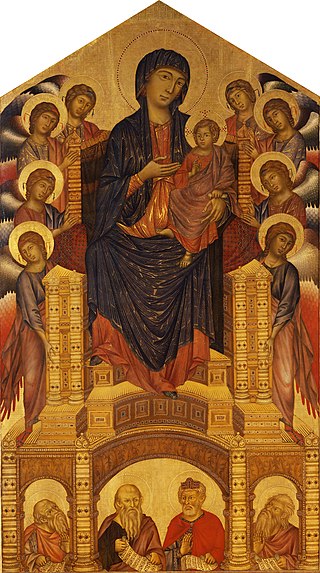
Giovanni Cimabue, c. 1240 – 1302, was an Italian painter and designer of mosaics from Florence. He was also known as Cenni di Pepo or Cenni di Pepi.

Arezzo is a city and comune in Italy and the capital of the province of the same name located in Tuscany. Arezzo is about 80 kilometres southeast of Florence at an elevation of 296 metres (971 ft) above sea level. As of 2022, the population was about 97,000.

Santa Maria Novella is a church in Florence, Italy, situated opposite, and lending its name to, the city's main railway station. Chronologically, it is the first great basilica in Florence, and is the city's principal Dominican church.

Spinello Aretino was an Italian painter from Arezzo, who was active in Tuscany at the end of the 14th and the first decade of the 15th century. His style influenced the development of late 14th- and early 15th-century painting in Tuscany.

The Basilica of Saint Francis of Assisi is the mother church of the Roman Catholic Order of Friars Minor Conventual in Assisi, a town in the Umbria region in central Italy, where Saint Francis was born and died. It is a papal minor basilica and one of the most important places of Christian pilgrimage in Italy. With its accompanying friary, Sacro Convento, the basilica is a distinctive landmark to those approaching Assisi. It has been a UNESCO World Heritage Site since 2000.

The Basilica of Saint Mary of the Angels is a papal minor basilica situated in the plain at the foot of the hill of Assisi, Italy, in the frazione of Santa Maria degli Angeli.
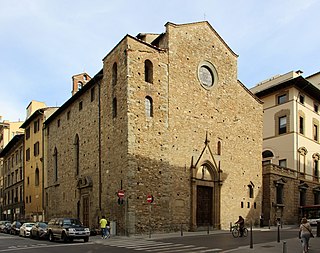
Santa Maria Maggiore di Firenze is a Romanesque and Gothic-style, Roman Catholic church in Florence, region of Tuscany, Italy. This is among the oldest extant churches in Florence.

The Basilica of San Francesco is a late Medieval church in Arezzo, Tuscany, Italy, dedicated to St Francis of Assisi. It is especially renowned for housing in the chancel the fresco cycle Legends of the True Cross by Piero della Francesca.

Lorenzo di Niccolò or Lorenzo di Niccolò di Martino was an Italian painter who was active in Florence from 1391 to 1412. This early Renaissance artist worked in the Trecento style, and his work maintains influences of the Gothic style, marking a transitional period between the Gothic sensibilities of the Middle Ages while simultaneously beginning to draw on the Classical. Lorenzo's works were usually religious scenes in tempera with gold backgrounds.

San Piero a Grado is a church in Pisa, Tuscany, Italy, in the eponymous frazione 7 kilometres (4.3 mi) west of the city center. The church is located where once was a now disappeared port of the Pisan Republic, where, according to the legend, St. Peter landed in Italy from Antiochia in 44 AD.

The Basilica of San Domenico, also known as Basilica Cateriniana, is a basilica church in Siena, Tuscany, Italy, one of the most important in the city. The basilica is an example of Cistercian Gothic style.

Arezzo Cathedral is a Roman Catholic cathedral in the city of Arezzo in Tuscany, Italy. It is located on the site of a pre-existing Palaeo-Christian church and, perhaps, of the ancient city's acropolis.
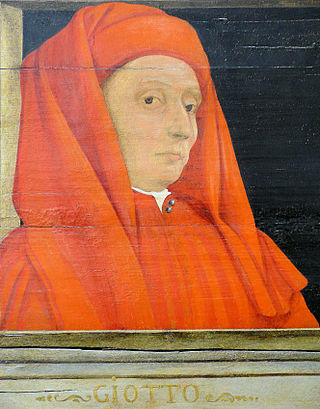
Giotto di Bondone, known mononymously as Giotto, was an Italian painter and architect from Florence during the Late Middle Ages. He worked during the Gothic and Proto-Renaissance period. Giotto's contemporary, the banker and chronicler Giovanni Villani, wrote that Giotto was "the most sovereign master of painting in his time, who drew all his figures and their postures according to nature" and of his publicly recognized "talent and excellence". Giorgio Vasari described Giotto as making a decisive break from the prevalent Byzantine style and as initiating "the great art of painting as we know it today, introducing the technique of drawing accurately from life, which had been neglected for more than two hundred years".
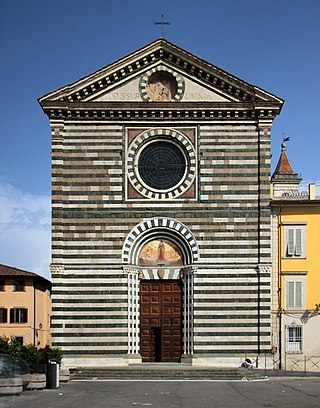
San Francesco is a Gothic-style, Roman Catholic church located in front of the square named after the church, in the historic center of Prato, region of Tuscany, Italy.
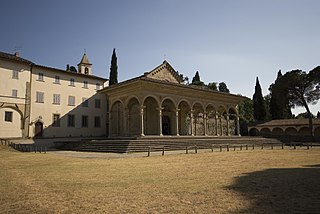
Santa Maria delle Grazie is a church in Arezzo, Tuscany, central Italy.
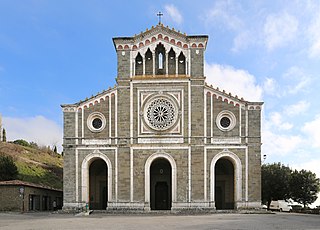
Basilica of Santa Margherita is a neo-Gothic style, Roman Catholic church, located just outside the Tuscan town of Cortona, Italy, at the intersection of Via delle Santucce and Via Sant Margherita, on a hill just below the Fortezza Medicea, and dedicated to a native saint of the town, Margaret of Cortona.

San Francesco is a Romanesque and Gothic-style, Roman Catholic church located at Piazza San Francesco in Pescia, region of Tuscany, Italy.
The Diocesan Museum of Sacred Art (MuDAS) in Arezzo was founded in 1963 but opened regularly to the public only in 1985, and was housed in several rooms above the sacristy of the Cathedral of San Donato. In 2011 it was relocated to the first floor of the bishop's residence. The museum exhibits works of art and liturgical items, from the 12th to the 19th centuries, that come from the cathedral and other churches in the diocesan territory, significant for their religious and cultural significance to Arezzo and the surrounding area. Highlights of the museum include several works of Giorgio Vasari and the Pace di Siena.

The Crucifix by Cimabue at Arezzo is a large wooden crucifix painted in distemper, with gold leaf, by the Florentine painter and mosaicist Cimabue, dated to c. 1267–71. It is the earliest of two large crucifixes attributed to him. It shows a painted representation of the near dead body of Christ on the cross, with Mary, mother of Jesus and John the Evangelist at either end of the cross beams.

Santa Maria or Santa Maria a Campi is a Roman Catholic parish church located on Via Spartaco Lavagnini #26 in Campi Bisenzio, just west of Florence, in the region of Tuscany, Italy.
43°28′09″N11°52′55″E / 43.4691°N 11.8820°E